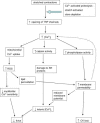Mechanisms of stretch-induced muscle damage in normal and dystrophic muscle: role of ionic changes
- PMID: 16002444
- PMCID: PMC1474216
- DOI: 10.1113/jphysiol.2005.091694
Mechanisms of stretch-induced muscle damage in normal and dystrophic muscle: role of ionic changes
Abstract
Muscle damage, characterized by prolonged weakness and delayed onset of stiffness and soreness, is common following contractions in which the muscles are stretched. Stretch-induced damage of this sort is more pronounced in the muscular dystrophies and the profound muscle damage observed in these conditions may involve similar pathways. It has been known for many years that damaged muscles accumulate calcium and that elevating calcium in normal muscles simulates many aspects of muscle damage. The changes in intracellular calcium, sodium and pH following stretched contractions are reviewed and the various pathways which have been proposed to allow ion entry are discussed. One possibility is that TRPC1 (transient receptor potential, canonical), a protein which seems to form both a stretch-activated channel and a store-operated channel, is the main source of Ca(2+) entry. The mechanisms by which the changes in intracellular ions contribute to reduced force production, to increased protein breakdown and to increased membrane permeability are considered. A hypothetical scheme for muscle damage which incorporates these ideas is presented.
Figures

References
-
- Alderton JM, Steinhardt RA. Calcium influx through calcium leak channels is responsible for the elevated levels of calcium-dependent proteolysis in dystrophic myotubes. J Biol Chem. 2000a;275:9452–9460. - PubMed
-
- Alderton JM, Steinhardt RA. How calcium influx through calcium leak channels is responsible for the elevated levels of calcium-dependent proteolysis in dystrophic myotubes. Trends Cardiovasc Med. 2000b;10:268–272. - PubMed
-
- Allen DG. Eccentric muscle damage: mechanisms of early reduction of force. Acta Physiol Scand. 2001;171:311–319. - PubMed
-
- Allen DG, Lännergren J, Westerblad H. Muscle cell function during prolonged activity: cellular mechanisms of fatigue. Exp Physiol. 1995;80:497–527. - PubMed
-
- Badalamente MA, Stracher A. Delay of muscle degeneration and necrosis in mdx mice by calpain inhibition. Muscle Nerve. 2000;23:106–111. - PubMed
Publication types
MeSH terms
Substances
LinkOut - more resources
Full Text Sources
Other Literature Sources
Medical
Miscellaneous

